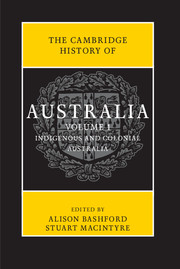Book contents
- Frontmatter
- Contents
- Abbreviations
- List of maps
- List of figures
- List of tables
- Notes on contributors
- Map
- Preface
- Introduction
- PART I
- PART II
- Further reading
- Chronology
- Index
- Frontmatter
- Contents
- Abbreviations
- List of maps
- List of figures
- List of tables
- Notes on contributors
- Map
- Preface
- Introduction
- PART I
- PART II
- 9 Religion
- 10 Culture and media
- 11 Science and medicine
- 12 Society and welfare
- 13 Gender and sexuality
- 14 Indigenous Australia
- 15 Class
- 16 The economy
- 17 Government, law and citizenship
- 18 Education
- 19 The environment
- 20 Travel and connections
- 21 Security
- 22 Australia, Britain and the British Commonwealth
- 23 Australia in the Asia-Pacfic region
- 24 The history anxiety
- Further reading
- Chronology
- Index
20 - Travel and connections
from PART II
Published online by Cambridge University Press: 05 November 2013
- Frontmatter
- Contents
- Abbreviations
- List of maps
- List of figures
- List of tables
- Notes on contributors
- Map
- Preface
- Introduction
- PART I
- PART II
- Further reading
- Chronology
- Index
- Frontmatter
- Contents
- Abbreviations
- List of maps
- List of figures
- List of tables
- Notes on contributors
- Map
- Preface
- Introduction
- PART I
- PART II
- 9 Religion
- 10 Culture and media
- 11 Science and medicine
- 12 Society and welfare
- 13 Gender and sexuality
- 14 Indigenous Australia
- 15 Class
- 16 The economy
- 17 Government, law and citizenship
- 18 Education
- 19 The environment
- 20 Travel and connections
- 21 Security
- 22 Australia, Britain and the British Commonwealth
- 23 Australia in the Asia-Pacfic region
- 24 The history anxiety
- Further reading
- Chronology
- Index
Summary
In 1909 the world's most famous Australian embarked on a 10,000 mile (16,000 kilometre) ‘sentimental tour’ of her homeland. After lessons and amateur concerts in Melbourne, ‘Madame’ Nellie Melba had carved her singing career in Europe: she studied in Paris, debuted in Brussels, appeared in the courts of St Petersburg, Vienna and Stockholm, became a fixture at Covent Garden and managed an affair with the Duc d'Orléans, the pretender to the French throne. For six months in 1909 she crisscrossed Australia, drawing adoring crowds in towns as far flung as Mount Morgan, Charters Towers, Bairnsdale and Ballarat, as well as the major cities. With her maid, her valet and two baby grand pianos, she travelled mostly by train, but also on steamers, carriages, horse-drawn buggies – even an undertaker's coach. In the New South Wales town of Dubbo she revelled in ‘the true Australian enthusiasm’ of her audience, which included a Goodooga family who had driven 145 kilometres by car through heavy rain to Brewarrina, and then 400 kilometres by rail to hear her sing. At Warwick in southern Queensland she was acclaimed as ‘the greatest Australian, feted by Kings, adored by the People’. As Melba's career and her tour demonstrate, even the dustiest Australian backblocks were connected to the world, both in practice and in the imagination. This chapter explores how Australians were increasingly connected to each other and the world during the twentieth century and how, through travel and tourism, mobility acquired meaning.
Overcoming distance
Colonial Australia's development had been constrained by the ‘tyranny of distance’, in Geoffrey Blainey's telling phrase, both across the continent and between Australia and the rest of the world. At the start of the twentieth century there was optimism that the tyranny could be overcome. This was part of the promise of modernity: a host of technological innovations produced by the second industrial revolution accompanied a new way of imagining the world as an interconnected network, ‘a vast, shared experience of simultaneity’.
- Type
- Chapter
- Information
- The Cambridge History of Australia , pp. 472 - 493Publisher: Cambridge University PressPrint publication year: 2013
- 4
- Cited by

